|
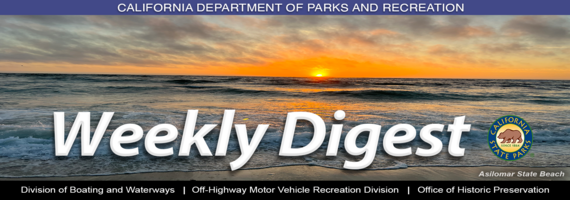 June 21, 2024
|
|
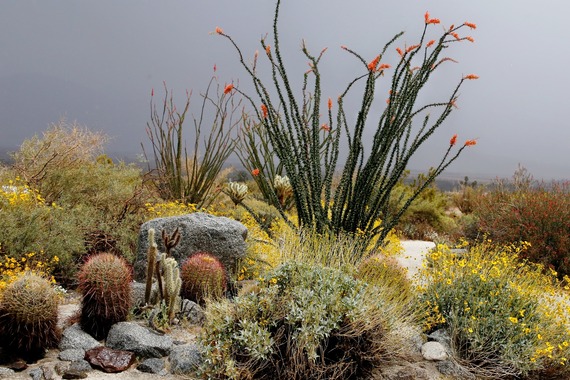 Anza-Borrego Desert State Park
Photo title: “Desert Splendor”
This is “Spring Senses” because: “Being out in Anza-Borrego in springtime is something I look forward to especially when a storm is coming through. The smell of wet earth, the feeling of the wind and the dramatic light are wonderful to experience. What made all of this even better this year were the blooming plants."
Photo taken: March 2024
Photo by: Michele Hernandez, Colorado Desert District. Michele is a state park interpreter and has been with State Parks for nine years.
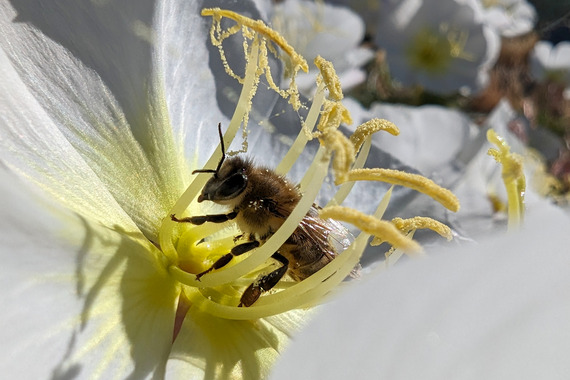 Antelope Valley Indian Museum State Historic Park
Photo title: “Plentiful Pollen Powders Busy Bee”
This is “Spring Senses” because: “While the incredibly wet winter did not favor poppies at the Antelope Valley California Poppy Reserve State Natural Reserve, elsewhere in the valley, conditions were perfect for other flowers. The birdcage evening primroses at the Antelope Valley Indian Museum were especially healthy and plentiful, giving pollinators loads of options. Here, we see a honeybee carrying out the symbiotic relationship, getting nectar from the flower, while also getting covered in heavy strands of pollen to be carried to the next location."
Photo taken: May 11, 2024
Photo by: Matthew Williams, Great Basin District. Matthew is a supervising state park peace officer and has been with State Parks for 16 years.
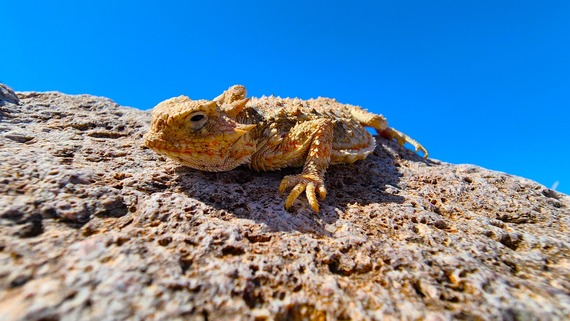 Providence Mountains State Recreation Area
Photo title: “Stay Still”
This is “Spring Senses” because: “Desert horned lizards (Phrynosoma platyrhinos) have such good camouflage that instead of running when confronted with a dangerous situation, they tend to freeze in place and blend in with their surroundings. Any potential predator’s sense of sight will not serve them as well while stalking these reptiles."
Photo taken: May 3, 2024
Photo by: Andrew Fitzpatrick, Inland Empire District. Andrew is a state park interpreter I and has been with State Parks for over 15 years. Andrew is a double top-photo winner in this contest. See second photo below.
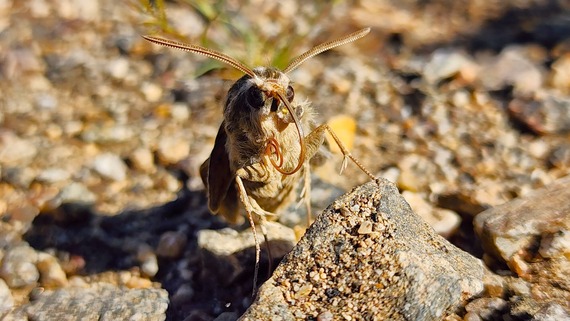 Providence Mountains State Recreation Area
Photo title: “The Riddle of the Sphinx (Moth)”
This is “Spring Senses” because: “The desert has a sense of mystery. To the untrained eye, it may appear to be a forbidding wasteland. But spend a little time here (especially in the spring) and one realizes it is far from empty of life. The white-lined sphinx moth (Hyles lineata) is a perfect example. As a full-grown caterpillar, it will burrow into the ground. After a few weeks, a fully-grown moth will crawl out of the earth. I was able to witness just this emergence and then capture close-up images of it as it dried its wings in preparation for flight. It is worth noting that this is a big creature: a 2 to 3-inch wingspan and a proboscis about as long for sipping flower nectar. They are so large and similar, they are often mistaken for hummingbirds, and are also known as 'hummingbird moths'."
Photo taken: April 17, 2024
Photo by: Andrew Fitzpatrick, Inland Empire District. Andrew is a state park interpreter I and has been with State Parks for over 15 years.
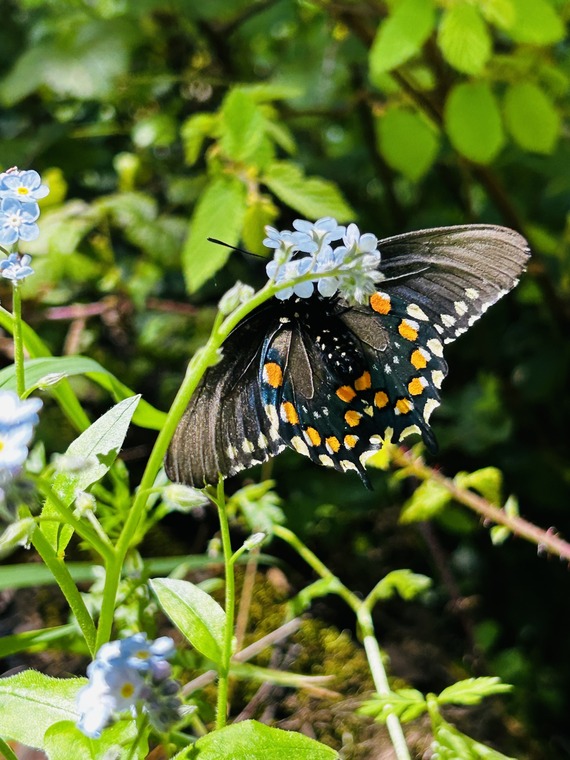 Samuel P. Taylor State Park
Photo title: “The Pipevine Swallowtail Show-Off”
This is “Spring Senses” because: “The Dutchman’s-pipe (Aristolochia macrophylla) has a period of dormancy in the fall/early winter and regrows in the late winter/early spring. Dutchman’s-pipe is the exclusive breeding ground of the pipevine swallowtail butterfly, which emerges in early spring to live its one-month long life to the fullest and lay eggs on the now fully-grown Dutchman’s-pipe's leaves. Butterflies are a quintessential representative of springtime, and the pipevine swallowtail butterfly stands out because of its color. The butterfly’s wings have black pigment, which reflect light on a molecular level that our eyes pick up as an iridescent blue. The orange spots indicate that the butterfly obtains a toxin. This toxin is obtained by eating the Dutchman’s-pipe leaves as a caterpillar and stays with the butterfly their whole lives. The toxin is used as a defense mechanism that is also passed down at the time the eggs are laid to deter predators."
Photo taken: April 9, 2024
Photo by: Kourtney Boone, Bay Area District. Kourtney is a state park interpreter I and has been with State Parks for two and a half years.
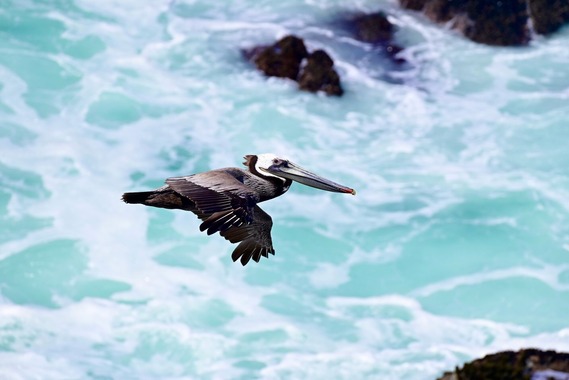 Sonoma Coast State Park
Photo title: “Brown Pelican”
This is “Spring Senses” because: “Springtime in coastal California is marked by the northbound migration of the brown pelican (pelecanus occidentalis). In the past, these magnificent birds were nearly driven to extinction due to pollutants like DDT. They were declared an endangered species in 1970, and the added protections allowed them to make a comeback. Brown pelicans can be observed soaring around the steep bluffs at Bodega Head every spring at Sonoma Coast State Park."
Photo taken: April 22, 2024
Photo by: Kenzi Lamb, Sonoma-Mendocino Coast District. Kenzi is a marine protected area interpreter I and has been with State Parks for three years.

|
|
State Parks Announces 21st Annual Director's Recognition Awardees, Congratulate Your Colleagues and Park Partners
Story from: Jorge Moreno, Communications and Marketing Division
 Help us celebrate your colleagues and park partners who are receiving a Director's Recognition Award for their amazing and outstanding accomplishments over the past year. This year’s 21st Annual Director’s Recognition Award ceremony will be virtual with a prerecorded video for you to hear about the incredible work staff, volunteers, and partners accomplished throughout the year. Information on how to view the full video will follow in the coming weeks.
Some of this year’s recipients are being recognized for adapting a sea level rise program, some for their heroic efforts during a high surf event, others for working with local tribes to conduct fuel reduction on State Park lands, and some for their work on natural disasters.
A special thank you to those of you who took the time and effort to nominate and honor your colleagues and partners for these awards. Your recognition of their achievements makes this awards program successful.
We hope you can join us in celebrating the accomplishments of our colleagues and the spirit of service and commitment to our mission.
Here are the 21st Annual Director's Recognition Awards recipients.
Annual Recognition Awards
Climate Adaptation Award: Recognizes those who have taken remarkable steps in preparing for and protecting against the adverse and imminent consequences of climate change, including wildfires, flooding, erosion, air pollution and droughts, as well as threats to park habitats, ecosystems, and people.
Michelle Succow – Natural Resources Division
Compass Award: Recognizes remarkable long-term visioning, innovative thinking and mentorship that fosters talent and provides support to staff at all levels.
Catherine Caldwell – Strategic Planning and Recreation Services Division
Equity and Diversity Award: Recognizes those who have made an exceptional contribution to ensuring all Californians have access to the outdoors and cultural sites and have significantly contributed to the department’s values of equity and inclusion.
Big Basin Planning Team – A collaboration between Santa Cruz District staff and Parks California.
Santa Cruz District: Will Fourt and Garret Hammack
Parks California: Myrian Solis Coronel, Emily Henry, Geoff Kish, Kindley Walsh Lawlor and Becky Rittenburg.
Innovation Award: Recognizes those who have demonstrated the remarkable ability to complete tasks and projects or address park problems through creative and innovative means.
2023 World Ocean Day Live Dive Team
Isabella Brown Alec Knapp Riley Rhodes
Brandon Caskey Kenneth Kramer Lydia Stinson
Erika Delemarre Jennifer Langer Mathew Trotter
Lee Hausner Kara Lu Ashley Wemp
Kayla Jones James Nothhelfer
Volunteers
Stan Burns John Ittelson Micheal Slade Eric Sturm Patrick Webster
Inspiration Award: Recognizes those who have achieved a major public objective while emphasizing community involvement.
Colorado Desert District - Native American Conservation Corps Team – A collaboration with Colorado Desert District staff, Native American Conservation Corps Field Team members, volunteers, and local tribe organizations.
Colorado Desert District
Donna Chandler Lisa Gonzales-Kramer
Fania DeLugo Frank Padilla
Hayley Elsken Zachary Staley
Emelyn Hernandez Hector Valencia
Mike Hopkins
Volunteers: Jen MacDonald and Tom Smith
Native American Conservation Corps Field Team Members
Anthony Alvarado Raymond Martinez Albert Quihuis
Dominick Chapparosa Wanish Tortes-McGinnis Jeremiah Sanchez
Josh Denmark Gary McVey Cullen Smith
Christian Dominguez Henry Najera Jacob Stone
Cory Knott Warren Paipa Edwin Ward
Andrew Leyva Donald Pena
Kumeyaay Diegueño Land Conservancy: Johnny Elliott and Lisa Haws
Resource Conservation District of Greater San Diego County: Ann Baldrige, Morgan Graves, Stan Hill and Heather Marlow
San Diego River Conservancy: Julia Richards
Kumeyaay Community College: Dr. Stan Rodriguez
La Jolla Reservation Fire Department: Wes Ruiz
Campo Kumeyaay Nation: Michael Connoly Miskwish
Leadership and Vision Award: Recognizes staff with the ability to motivate and inspire others to positive action and who have demonstrated a long-term commitment to the ideals and values of the department.
April Marson – Diablo Range District
Partnership Award: Recognizes partners who have demonstrated a high level of commitment over a substantial period toward accomplishing the department’s mission.
Leonard Wilson – Mojave River Natural History Association
Professional Integrity Award: Recognizes employees who demonstrate a high degree of honesty, integrity, and idealism in the face of adverse pressure.
Larissa Ison and Lisa Jaycox– Park Operations Division
Resilience Award: Honors an individual or team who tirelessly and valiantly rose to enormous challenges during an emergency response situation and/or recovery effort.
Jake Bentley – Santa Cruz District
Trailblazer Award: Recognizes those who have introduced new ideas or methods to accomplish the mission of State Parks or pioneered new ways to introduce the public to California’s outdoors.
Brooke Sullivan – Bay Area District
Special Commendation Awards: Recognizes employees who have made a significant contribution by going above and beyond the norm and made a substantial impact.
Eric Draper – Sierra District
Facility Ignition Prevention Program Team: Kathleen Kennedy, Branigan Schoppman, Peter Saelee and Brooke Sheridan
Leah Gardner – Natural Resources Division
Kathleen Kennedy – Cultural Resources Division
Jimmy Low – Strategic Planning and Recreation Services Division
Special Act or Service Awards: Recognizes employees who have performed an extraordinary act of heroism extending far above the normal call of duty or service and who performed at great risk to their own safety in an effort to save human life and/or property.
Michael “Clyde” Cafferty – Colorado Desert District
Matthew Cantelme – Inland Empire District
Jake DiNolfi and Jaycee Hollins – Oceano Dunes District
Cameron Faris – Orange Coast District
David W. Flanagan – Oceano Dunes District
Maxwell Hunter and Riley Rhodes – Santa Cruz District
Justin Quiggle – Orange Coast District
Channel Coast District High Surf Response Team
Tim Allen Jackson Feller Priscilla Soto
Brandon Alvarez David Flora Ryan Stolla
Scott Anderson Skylar Goodner Benjamin Sweet
Ted Anning Winnie Hsaio Mary Thorne
Richard Barry Kai Huff Dion Von Der Leith
James Bray Casey Huffman David Wilson
Wyatt Calhoun Maria Mendez Katherine Wilson
Ross Carey Chris Pistone Jaret Wrobel
Ray Cervantez Greg Shaner William Wulff
Eric Fedde Sydney Smith
Learn more about the Director’s Recognition Award Program on the intranet.
Theme for Summer Photo Contest: 'Escape to the Outdoors'
Story from: Gabriela Orozco, Communications and Marketing Division
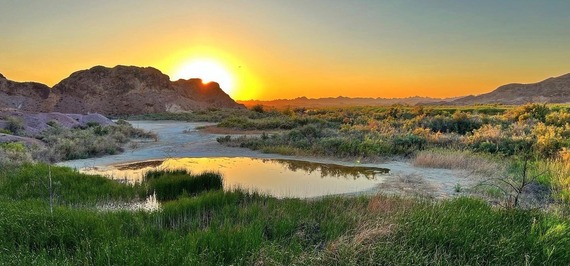 Sunset at Picacho State Recreation Area. Photo by Adrien Contreras, Park Operations Division.
State Parks staff and volunteers submitted many remarkable pictures for the “Spring Senses” photo contest, with most of the top photos showcasing critters thriving in their natural habitats within state parks. Like the previous contest, we received tons of impressive photos that we selected six winners (see the winning photos at the top). Congrats to the "Spring Senses" contest winners, and a big thank you to everyone who participated in the contest!
The winning photos will be shared the week of June 24 on California State Parks’ social media accounts (Instagram, Facebook and X). Make sure to check them out and give them a like, share, or comment on your favorite photos.
For the summer season, we want you to show us how you have fun disconnecting from daily routines and reconnecting to nature through the “Escape to the Outdoors” photo contest. For this contest, submissions can include photos you take outdoors during a fun activity, like bicycling, hiking, or camping. With 280 parks to explore, you are bound to capture striking photos of wildlife roaming the parks, sunsets and sunrises, landscapes, or even historical buildings. Make sure to share those with us for a chance to have a winning photo and to inspire others with your unique perspective of summertime in state parks.
The “Escape to the Outdoors” photo contest runs from June 21 through Sept. 10, 2024. As a friendly reminder, if your photos include people who are not State Parks employees or volunteers, you must have a Visual Media Consent form (DPR 993).
To be eligible to participate, you must be a State Parks employee or park volunteer and submit your photos to the Weekly Digest. Provide a brief caption for your photo and the name of the state park it was taken in. The Communications and Marketing team will announce the top photos in September 2024. The photos will be shown in the Weekly Digest, as well as State Parks’ social media channels with their photo credit.
Here are the rules and criteria to submit photos:
- Send photos to the Weekly Digest email address with the subject line “Escape to the Outdoors.”
- Photos must be taken between June 21-Sept. 10, 2024.
- Photos with images of those who are not park staff or volunteers must include a photo Visual Media Consent form (DPR 993).
- Photos can be taken at any of California’s 280 state parks or at a State Parks office.
- Only park employees and volunteers can submit photos.
- Photos will be judged on photo quality, uniqueness, moment captured and content.
- The top five photos chosen will be shared on California State Parks’ social media channels and in the Weekly Digest.
- Photos will be judged by the Communications and Marketing team (whose members are not eligible to participate in the contest).
- Photo images should be a minimum of 1,920×2,400 ppi.
If you have any questions on the contest, please send an email to the Weekly Digest. We look forward to seeing the beauty of the great outdoors through your lens.
  
|
|
Post Fire Impacts Hungry Valley State Vehicular Recreation Area
Story from: Kevin Overduin, Great Basin District
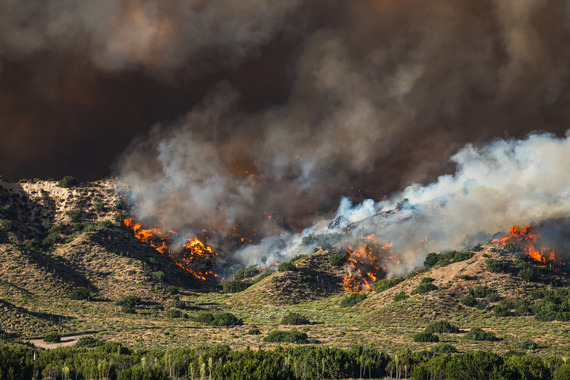 The Post Fire as seen from Lower Scrub Oaks Campground at Hungry Valley State Vehicular Area, looking east at Rattler Trail, Antler Trail, and Flying W Trail. Photo by Bobby Scruggs, Great Basin District.
Hungry Valley State Vehicular Recreation Area (SVRA) staff and visitors were greeted by an unfortunately familiar sight as a thick smear of tan and black smoke broke over the vibrant chaparral ridges of the park at 1:47 p.m. on June 15. After a year of decent rainfall followed by the high, drying temperatures that Hungry Valley SVRA has grown accustomed to, the fire began to spread quickly from its origination point on Interstate 5. A quick wind blew south, carrying the flames at an incredible rate of speed - 80 to 100 feet a minute. Almost immediately, there was damage to vehicles and buildings in the nearby town of Gorman.
A small spark soon became the Post Fire, another incident which demanded an aggressive response from many agencies that responded to assist in the defense of life and property. As State Parks staff arrived at the scene, they did so under a sky-blotting cloud of ash and the red light of the sun filtered through plumes of smoke.
The images were sobering and undoubtedly like many that State Parks’ staff and visitors have had to endure in recent years. Initial plans and contingency plans were swiftly developed and carried out, and the park was quickly evacuated due to the immediate threat to visitor safety. Parks staff and crews from various agencies worked tirelessly through long days and nights. Several times the fire threatened offices, vehicles, and residences, but each time the fire was beaten back. Fire engines of every type filled the roadways, and planes and helicopters made strategic water and retardant drops.
When the sun rose again in a clearer sky, the Post Fire had burned over 15,000 acres, 10,064 of which was inside Hungry Valley SVRA. Because of the decisive actions of the fire crews, the only structure lost was the park’s south kiosk. With uniforms and trucks smelling like acrid smoke and charcoal in the wheel wells, State Parks’ staff stood over a desolate landscape. Where once were fields of buckwheat, groves of oak, and hills of grassy wildflowers, there was now charred ground and smoking ash.
There is much work to do to salvage and preserve the resources of this beautiful place which generations have enjoyed. However, without the efforts of State Parks staff and emergency response crews, the losses would have been undoubtedly worse. Great Basin District staff would like to thank the response and efforts of the countless agencies that assisted, and continue to assist, during and following this incident.
*Editor’s note: Hungry Valley SVRA is currently temporarily closed. For the latest updates on park impacts, please visit parks.ca.gov/incidents and for the latest updates on wildfires, visit CAL FIRE’s webpage at fire.ca.gov.
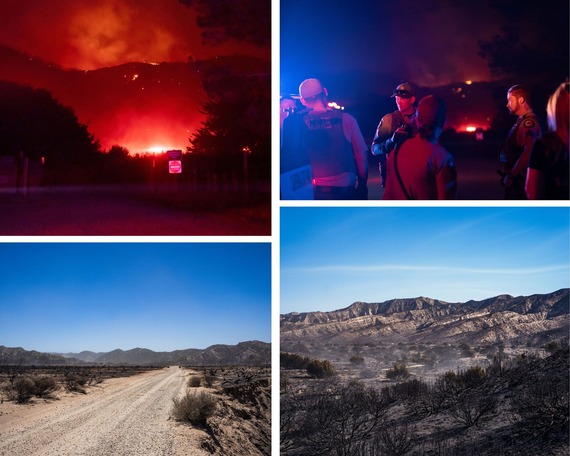 Clockwise from top left: Fire burning through Mystic Canyon. Great Basin District State Park rangers debriefed on earlier actions and planning for night operations. A smoldering landscape looking east from Pipeline Trail toward Lower Freeman Trail. Scarred brush along both sides of Hungry Valley Road. Photos by Bobby Scruggs, Great Basin District.
A Busy Opening Week for Dos Rios, California's Newest State Park
Story from: Paige Haller and Caitlin Torres, Central Valley District
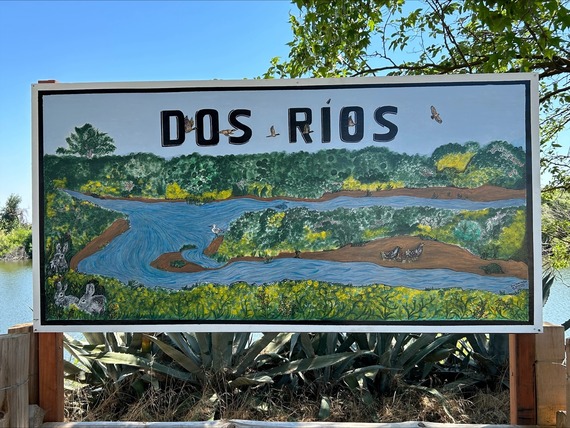 The mural at California's newest state park was completed on June 19. Photo from Paige Haller, Central Valley District.
Since the official opening of Dos Rios on Wednesday, June 12, the newest state park has had a busy first week. We have had quite a lot of curiosity and interest. Visitors have steadily come by Dos Rios to check out what the new park is about. Over the first five days of operation, we welcomed nearly 1,900 people!
On Saturday, June 15, Dos Rios continued to celebrate California State Parks Week with a "Community and Culture Day". We welcomed members of various local tribes, including the Northern Sierra Miwok, as we learned about basket weaving, acorn preparations, and traditional dance. Visitors were able to enjoy Native American food as well. The event began at 9 a.m. with a land blessing, followed by Native American dancing, demonstrations, and vendors. We found that some visitors even brought out their kites as the wind picked up.
“Community and Culture” was a fitting theme for Dos Rios' California State Parks Week event because plans for greater access and recreational opportunities in the park will involve a public engagement process that includes consultation with area tribes. You can learn more, provide input, and follow the progress at the Dos Rios Classification and General Plan website.
On June 21, we began our regular, daily guided tours and all are currently at capacity. To join a tour in the future, please visit parks.ca.gov/DosRios.
Thank you again for the support leading up to Dos Rios’ opening.
 Top: The Community and Culture Day included Foothill Miwok dancers. Photo from Ali Manzo, Central Valley District. Vendors (bottom left) and basketry on display (bottom right). Photos from Caitlin Torres, Central Valley District.
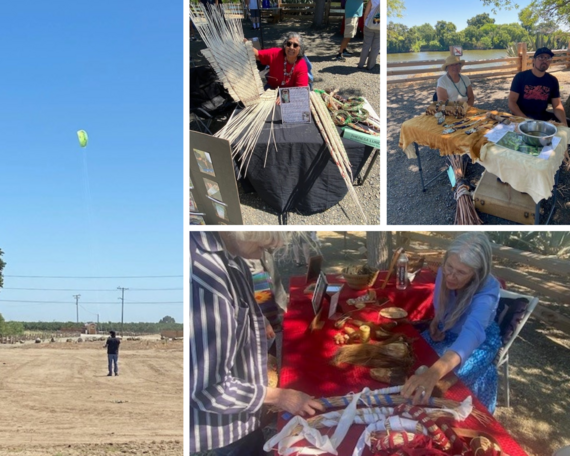 Left: Some visitors at the park's Community and Culture Day brought out their kites. Middle top and top right: Tribal members display twined basketry and Northern Sierra Miwok string making. Bottom right: North Fork Mono/Chukchansi Lois Bohna demonstrates the making of soap root. Photos from Caitlin Torres, Central Valley District.
Lighthouse Restoration Continues at Pigeon Point Light Station State Historic Park
Story and photos from: Julie Barrow, Santa Cruz District
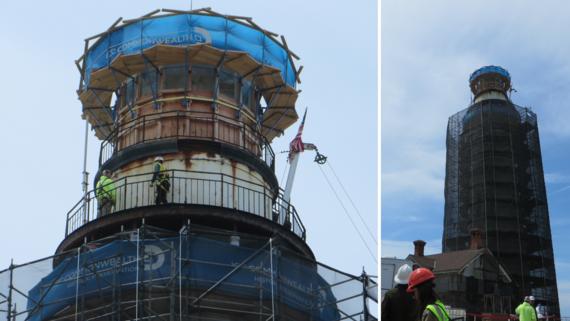 Left: The design team inspects ironwork on the upper tower. Right: Scaffolding and sheeting surround Pigeon Point Lighthouse in preparation for lead (paint) removal.
With the winter rains finally over, work is beginning in earnest on the restoration of Pigeon Point Lighthouse at Pigeon Point Light Station State Historic Park. The crew was able to take advantage of the rains to prepare the interior of the structure for hazardous materials abatement, particularly lead and asbestos, by wrapping the stairs, landings, and floors. Two rings of bracket scaffolding were installed, one just below the lower gallery and the other around the top portion of the lantern room.
Behind the scenes, the contractor has been submitting discreet plans and protocols to address various elements of the project, from the hazmat protocols to materials specifications to procedures for conducting the investigative probing. This process will continue throughout the construction project to inform and guide the work as it is performed.
In the past few weeks, full scaffolding covering the body of the tower has been installed to provide for lead (paint) removal in a systemized section-by-section manner. Also, preliminary investigative probing has begun to determine the condition of the ironwork and brick and mortar in the upper interior and lower exterior belt courses.
The state’s design team met onsite with the construction crew in mid-June to discuss the condition of the ironwork and possible methods of proceeding. They also looked at options for removing the lead-based paint on the exterior and interior of the brickwork. The contractor expects to begin selective demolition in early July.
Stay tuned for more updates as the work continues.
Community Homecoming Celebration at Malakoff Diggins State Historic Park's Annual Humbug Day
Story from Jean Rhyne, Sierra District
 Clockwise from top: E Clampus Vitus parade vehicles Engine 10 and Clementine, in the World’s Shortest Parade. Lacemaking demonstrated by Gold Country Lace Makers. Hydraulic monitor sending a stream of water 150 feet down North Bloomfield Road. Photos from Brian Baer, Communications and Marketing Division.
The town of North Bloomfield came alive with festivities on Saturday, June 8. The annual Humbug Day event began in 1966, after Malakoff Diggins State Historic Park was established, as a homecoming celebration for the former residents and descendants of North Bloomfield.
Today, the event celebrates the cultures of the mining town that developed around hydraulic mining and recognizes the impacts hydraulic mining had on the environment and the history of California. It was because of the flooding and destruction downriver, caused by hydraulic mining’s tailings, that the first environmental protection court decision was passed.
Visitors were treated to the annual demonstration of the hydraulic water monitor, sending a stream of water arcing 150 feet down the main street. Humbug Day’s “world’s shortest parade” featured parade vehicles, Clementine and ECV Engine 10, from E Clampus Vitus, a fraternal organization dedicated to the preservation of the heritage of the American West that has been vital to the restoration of North Bloomfield.
Also present were Supervising Ranger Ryan Randar, resident park staff, and fire trucks from Sierra District fire crew, North San Juan Fire Department, U.S. Forest Service-Tahoe National Forest, and CAL FIRE Station 20 from Nevada City. They went around three times in case anyone blinked and missed this short parade!
Park docents, dressed in period attire, welcomed visitors in the restored historic buildings decorated with items from the early 1900s, such as the McKillican and Mobley General Store, and the Smith-Knotwell Drug Store. In the King’s Saloon, visitors enjoyed a root beer at the bar while musician Jackie Galloway played accordion. E Clampus Vitus also served barbecue lunch in the center of town. Coco’s Ice Cream and the cooperating association’s snow cones were also very popular.
Planting heirloom vegetables in a take-home cup was a new activity this year that interpreted the role of Chinese miners as providers of fresh vegetables in mining towns. Visitors also enjoyed candle dipping, tin punching, playing historical children’s games, and watching demonstrations of lacemaking, weaving, and blacksmithing while some lucky visitors got to take home gold from the gold panning troughs.
This annual event is organized in cooperation with the Sierra Gold Parks Foundation, a nonprofit organization that supports educational and interpretive programs for the three California state parks in Western Nevada County.
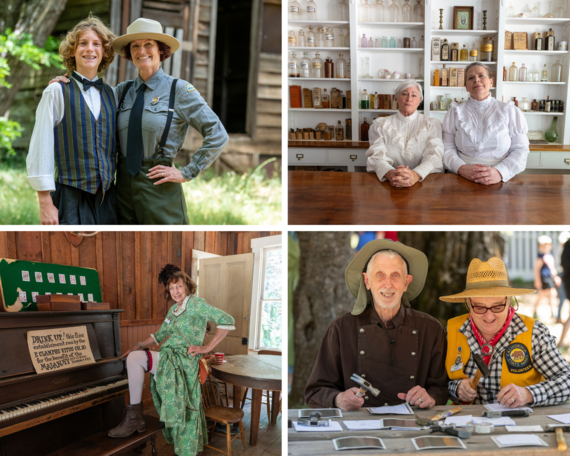 Clockwise from top left: State Park Interpreter Jean Rhyne and son Elijah Rhyne. State Park docents Katharine Hullinger and Andrea Broughton would like to know what ails you. State Park docents Jim Strahan and Laura Boatman try their hand at tin punching. State Park docent and “Conversation Girl” Linda Mazur in King’s Saloon. Photos from Brian Baer, Communications and Marketing Division.

Ocean Warming Insights from the 50-Year Partnership of State Parks and Scripps Institution of Oceanography
Story from: Parks California
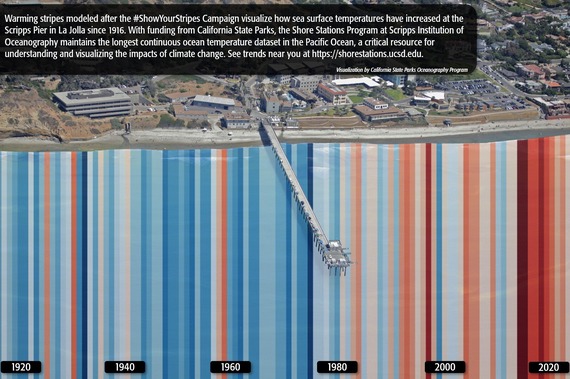 Warming stripes modeled after the #ShowYourStripes Campaign visualize how sea surface temperatures have increased at the Scripps Pier in La Jolla since 1916.
“Climate change relative to what…?” is a central question for climate science.
How climate changes and how fast depends on what the reference is. The most common reference is conditions before the human-induced effects of the Industrial Revolution kicked in sometime between 1800 and 1850. This exemplifies how the longest instrumental records such as those of sea level, and ocean temperature and salinity provide irrefutable evidence that global climate has changed over the past 200 years, and how.
As stewards of roughly a quarter of the coastline, State Parks relies on long-term data to guide assessment, mitigation, and adaptation of our coastal parks and beaches for the inevitable impacts of climate change.
#ShowYourStripes Day is on June 21, 2024, and is part of an internationally observed campaign to spread awareness about climate change. The campaign uses the iconic “warming stripes” graphic to visualize and display average annual temperature trends over more than 100 years. Blue (cooler) to red (warmer) colors illustrate temperature gradients each year, with darker colors representing more extreme temperatures, both cold and warm.
State Parks and Scripps Institution of Oceanography (SIO) adapted the #ShowYourStripes concept to display ocean temperature changes over time. These powerful visualizations show substantial variability with obvious, strong warming along the California coast since about 1980.
In anticipation of #ShowYourStripes Day, Parks California talked about these observations with three scientists from SIO and State Parks who manage one of the world’s longest sea surface temperature monitoring programs.
Beginning as early as 1916, the SIO Shore Stations Program, implemented by countless volunteers, students, partners, faculty, and researchers, has collected daily temperature and salinity measurements at 10 stations along the California coast from Humboldt to La Jolla. These data are the longest continuous records in the Pacific. For more on this, read the interview here.
  Email photos to the WeeklyDigest@parks.ca.gov.

|
|
|
To view current job openings within California State Parks, please visit our jobs webpage at www.LiveTheParksLife.com.
State Parks Job Spotlights and Open Exams
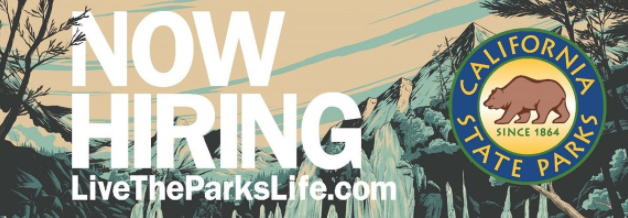 JOB SPOTLIGHTS
Environmental Scientist – (Multiple opportunities) – Apply-by dates vary: In these roles, you will dive into the forefront of environmental sustainability. Gather vital data, conduct insightful analysis, and craft influential reports and regulatory documents. Your work will positively impact the natural resources of our state parks, engaging with communities to foster sustainable solutions. Ready to lead the charge? Click here to view current opportunities and to apply.
Maintenance Aide (Multiple opportunities) – Apply-by dates vary: No degree required. This is the perfect entry-level position to get started at State Parks. Perform various maintenance and housekeeping tasks necessary to ensure that public health and safety standards are maintained. Click here for more information. No assessment required.
Park Maintenance Worker I – (Multiple opportunities) – Apply-by dates vary: State Parks is seeking multiple motivated individuals to take on these dynamic roles. From carpentry, painting, and everything in between, you'll maintain, repair, and build diverse park structures and facilities. Clear trails, protect natural resources, and lead a team—all while keeping our parks pristine. Ready to make a hands-on impact in preserving our outdoor havens? Click here to view opportunities and to apply.
State Park Equipment Operator – (Multiple opportunities) – Apply-by dates vary: As a State Park Equipment Operator, you will be responsible for operating heavy equipment to construct roads, maintain packing areas and remove various hazards, including dead trees, landslides, and flood debris. You may also operate light equipment including chainsaws, lawn mowers, repair fences, etc. Click here to view opportunities and to apply.
Water and Sewage Plant Supervisor (Multiple opportunities) – Apply-by dates vary: As a Water and Sewage Plant Supervisor, your role will be an essential part of maintaining the beauty of our state parks by ensuring clean waterways and sustainable facilities. In these exciting roles, you will supervise the operation of a water treatment and/or sewage treatment plant, direct the taking of daily tests of water and sewage, and other vital tasks. Click here to view the current openings and to apply.
EXAM SPOTLIGHTS
Communications Operator – Continuous (Applications will be processed the first day of every month): This is the entry, working, and journey level for this series. Employees work under general supervision in a Communications Center, following established policies and procedures to perform a variety of duties. Click here for more information.
Water and Sewage Plant Supervisor – Continuous (6/30/2024): You will be supervising the operation of a water treatment and/or sewage treatment plan, directing the taking of daily tests of water and sewage in the various stages of treatment, and making the more involved analyses by interpreting tests and determining necessary changes in dosage and treatment processes. Click here for more information.
Museum Curator I (7/31/2024) – Guided by general direction, the Museum Curator I will skillfully plan and oversee programs for acquiring, conserving, and interpreting museum objects within park area or house museums. From preservation to storage, they ensure each artifact's significance is preserved and shared with care. Click here for more information.
Museum Curator II (7/31/2024) – The Museum Curator II leads strategic programs for managing museum collections in facilities with active yet moderate-sized holdings. From acquisition to storage, they ensure each artifact is carefully preserved and its story is vividly told. Click here for more information.
Museum Technician (7/31/2024) – As a Museum Technician, you will safeguard and maintain art collections with precision. Your duties will also include specialized cleaning, pest control, and climate management. You will contribute to preservation efforts through inventory management and record-keeping, while ensuring safe object relocation. Click here for more information.
If you have any questions regarding these opportunities, connect with us at Recruiting@parks.ca.gov. We’re happy to help!
Interested in more jobs and exams like this? Explore www.LiveTheParksLife.com to discover the possibilities.
Join the Parks Jobs mailing list here. We can send you updates on jobs and exams that interest you!
 
|
|
|
Style time! Here are this week's tips to help spread the word about our departmentwide style guidelines:
-
gopher snake: Two words.
-
honeybee, honeycomb, honeysuckle: All one word.
-
paddleboard, stand-up paddleboarding: “Paddleboard” is one word; “stand-up” is hyphenated before “paddleboarding.”
Keeping a consistent writing style ensures the Weekly Digest looks and sounds its best. Each week, the Communications and Marketing Division reviews submitted articles for proper grammar and punctuation and style consistency––from capitalization and hyphenation to proper acronyms and active/passive voice usage. In general, we follow the Associated Press style and Merriam-Webster, but at times we use our own department-specific style.
We always welcome your feedback on how to “Live the Parks Life” in (writing) style. Connect with us via email at weeklydigest@parks.ca.gov.
|
|
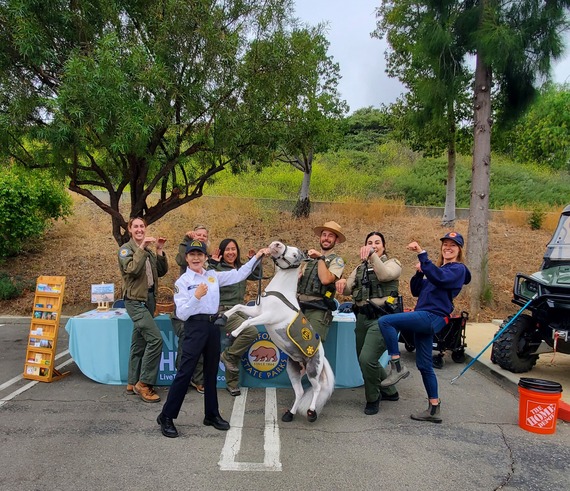 Angeles District
Angeles District staff found their very own Li'l Sebastian! On Saturday, June 8, staff joined the Calabasas Safety Fair where they taught participants about wildfire safety, invasive plants, local animals and how to get involved in their parks. Blue Moon, the miniature horse, and her handler Veronica from the nonprofit organization, Mini Therapy Horses, had a great time stopping by our booth. Pictured (left to right): Ilsa Buelow, state park interpreter, Veronica, mini therapy horse handler, Jenny Gagnon, staff services analyst, Christina Kajitori, staff services analyst, Blue Moon, mini horse extraordinaire, Andrew Fewsmith, state park peace officer, Gina Romero, state park peace officer and Megan Edic, environmental scientist.
Photo from Angeles District staff
 Folsom Lake State Recreation Area
State Parks HQ staff participated in a paddleboarding event at the Sacramento State Aquatic Center on Lake Natoma during California State Parks Week. From left to right: Annie Yang, Human Resources; Angelica Guzman, Human Resources; Thu Le, Accounting; and Rubi Deniz, Human Resources.
Photo from Rubi Deniz, Human Resources
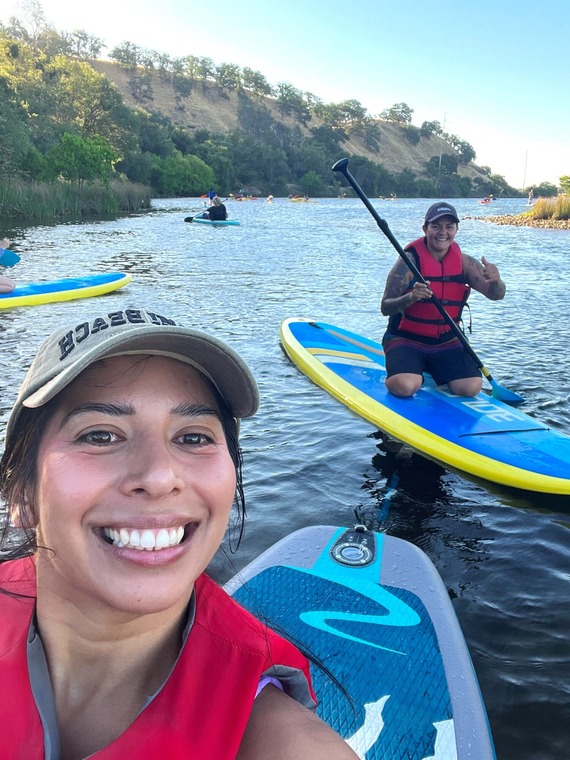 Folsom Lake State Recreation Area
Rubi Deniz (left) and Angelica Guzman (right) take a photo on their paddleboards on Lake Natoma.
Photo from Rubi Deniz, Human Resources
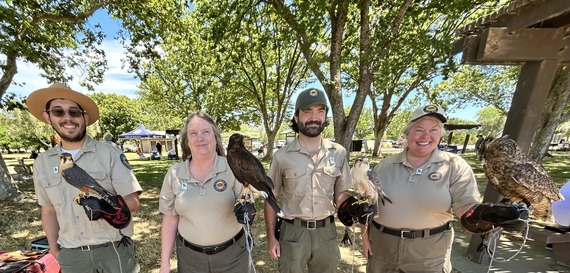 Lake Oroville State Recreation Area
During California State Parks Week, staff hosted raptors at the North Forebay from West Coast Falconry. Pictured (from left to right): Interpreter I Noel Lopez, Interpretive Park Aid, Senior Park Aid Lisa Sannar, Interpreters I Quinn Neves and Amanda Sellers.
Photo from Amanda Sellers, Northern Buttes District
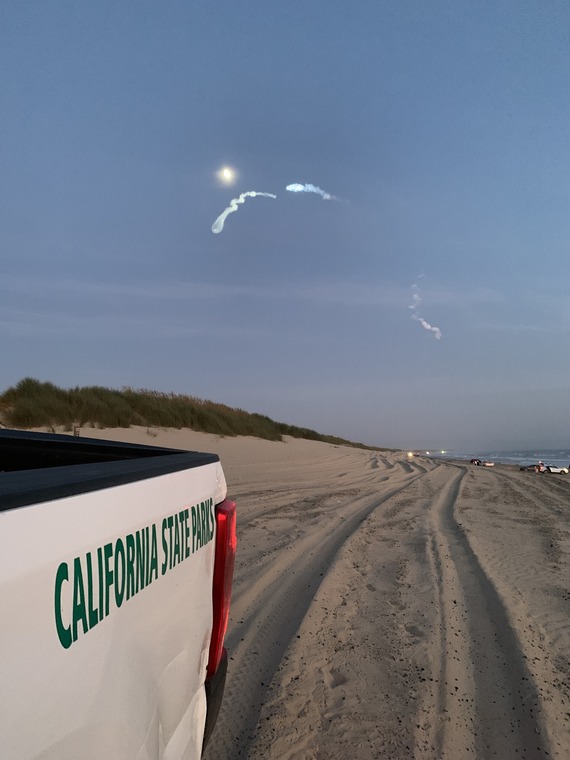 Pismo State Beach
Sunset rocket launch from Vandenberg Space Force Base.
Photo from Hejin Burris-Lee, Oceano Dunes District
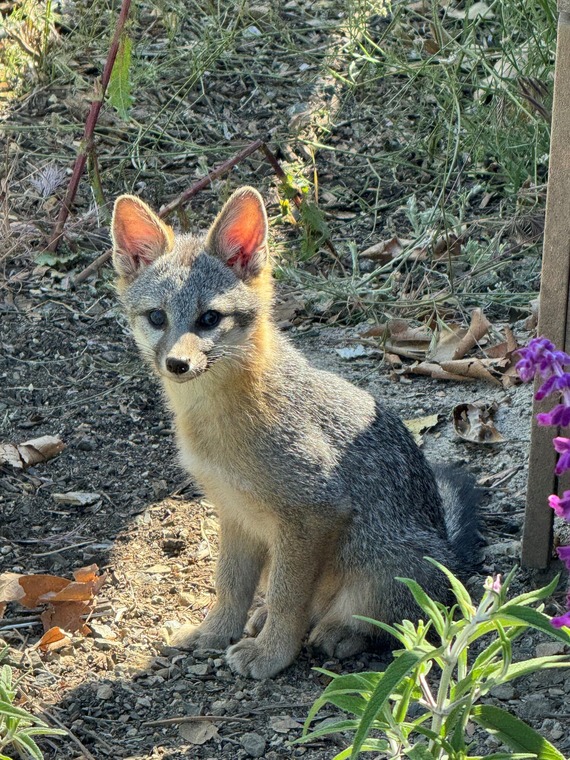 Hearst San Simeon State Historical Monument
A baby gray fox outside of the San Luis Obispo Coast District Office.
Photo from Jessica Harvey, San Luis Obispo Coast District
 Cuyamaca Rancho State Park
A western tree squirrel.
Photo from Michele Hernandez, Colorado Desert District
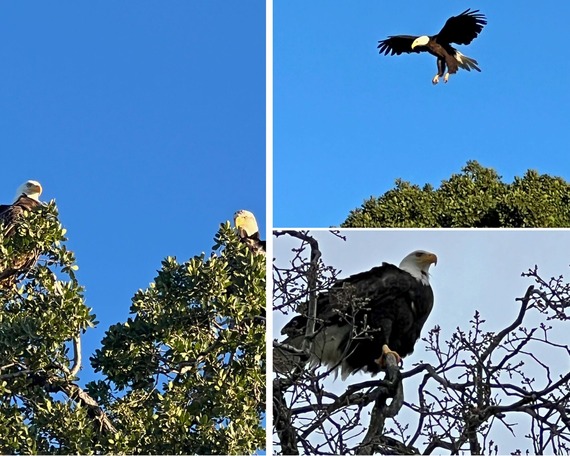 Folsom Lake State Recreation Area
Bald eagles in residence at Beals Point.
Photos from Kacie Mack, Gold Fields District
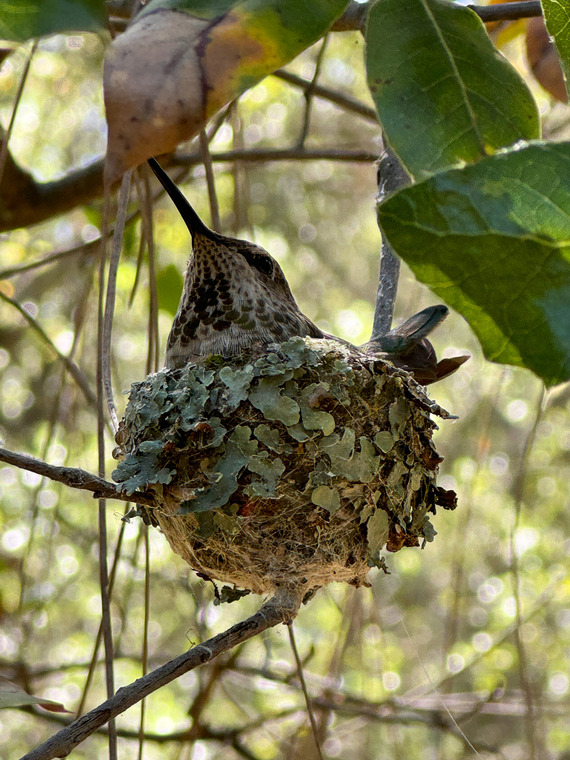 Folsom Lake State Recreation Area
Nesting female Anna's hummingbird.
Photo from Leenna Keo, Gold Fields District
 Torrey Pines State Natural Reserve
On a hike through the Beach Trail, I photographed a native bee feeding from the nectary of a Calochortus weedii weedii flower.
Photo from Pamela Taylor, Inland Empire District
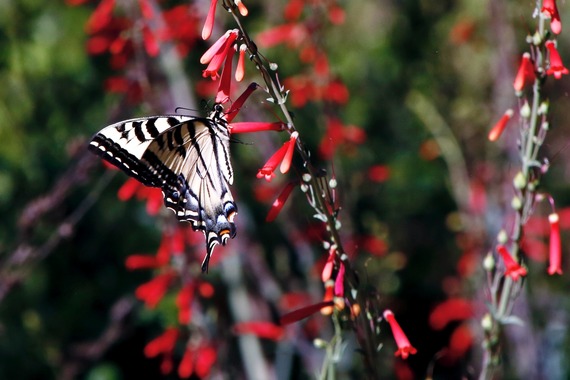 Cuyamaca Rancho State Park
A western tiger swallowtail feeding on a scarlet bugler.
Photo from Michele Hernandez, Colorado Desert District
 Cuyamaca Rancho State Park
Two coronis fritillaries feeding on a California thistle.
Photo from Michele Hernandez, Colorado Desert District
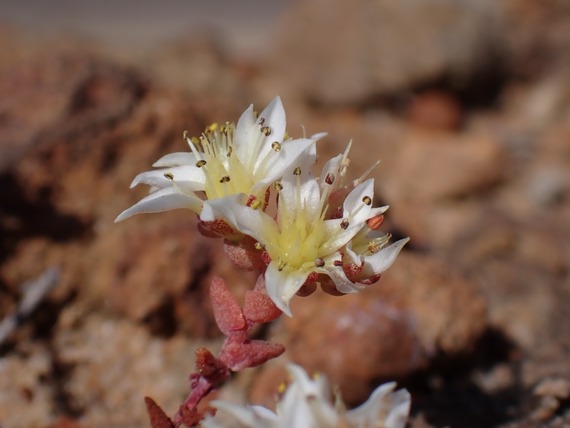 Torrey Pines State Natural Reserve
Dudleya brevifolia (short-leaved dudleya) is a rare plant known only from a few populations and confined to an extremely limited range, centered around Torrey Pines. It grows on the bare surface of Torrey sandstone bluffs.
Photo from Pamela Taylor, Inland Empire District
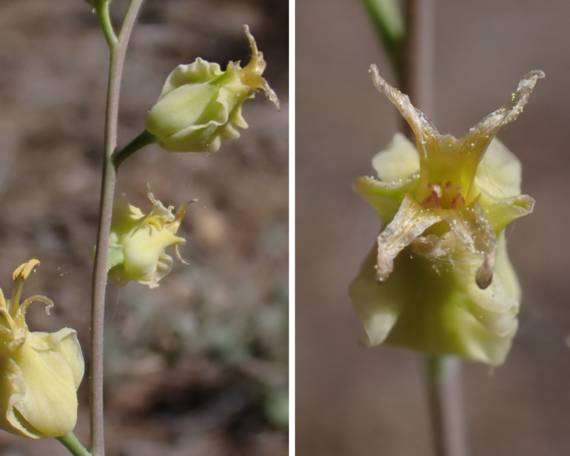 Mount San Jacinto State Park
Bell-shaped flowers of the rare Laguna Mountains jewelflower (Streptanthus bernardinus) seen at the park. It is a member of the mustard family, Brassicaceae.
Photos from Pamela Taylor, Inland Empire District
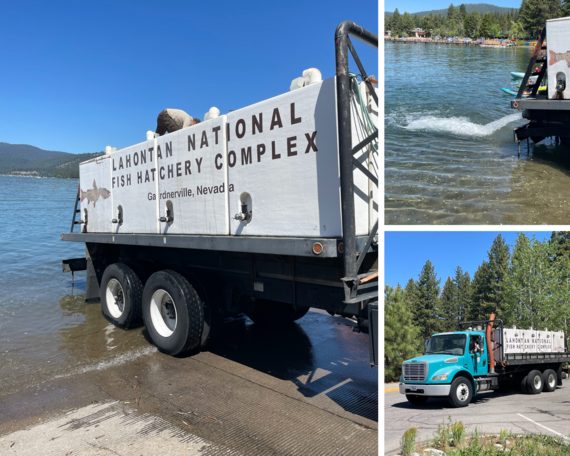 Kings Beach State Recreation Area
Reintroduction of previously endangered native Lahontan cutthroat trout reintroduction to Lake Tahoe on June 13 in conjunction with elders, elected officials, and child members of the Washoe Tribe of Nevada and California, as well as members of the public, including local Boys and Girls Club.
Photos from Robert Griffith, Sierra District
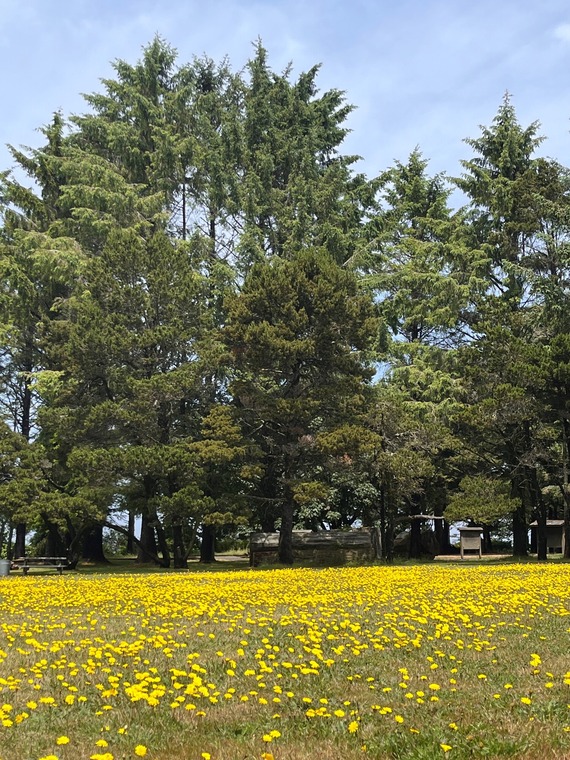 Fort Humboldt State Historic Park
Everything is coming up daisies!
Photo from Ashley Disney, North Coast Redwoods District
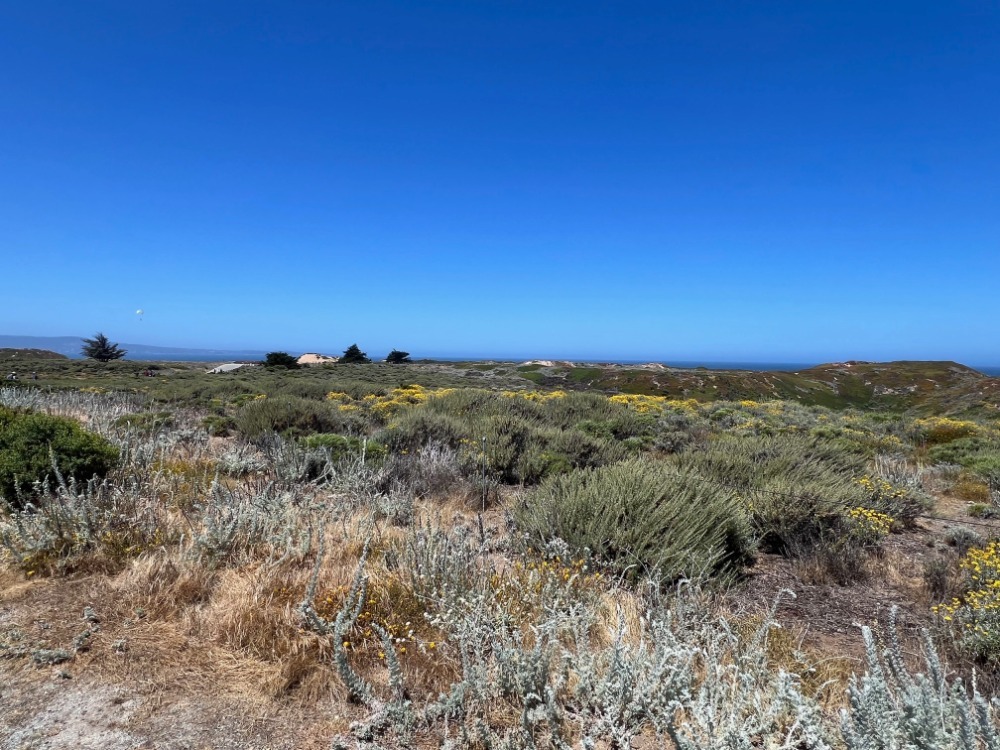 Ford Ord Dunes State Park
Overlooking the ocean.
Photo from Keira Silver, volunteer
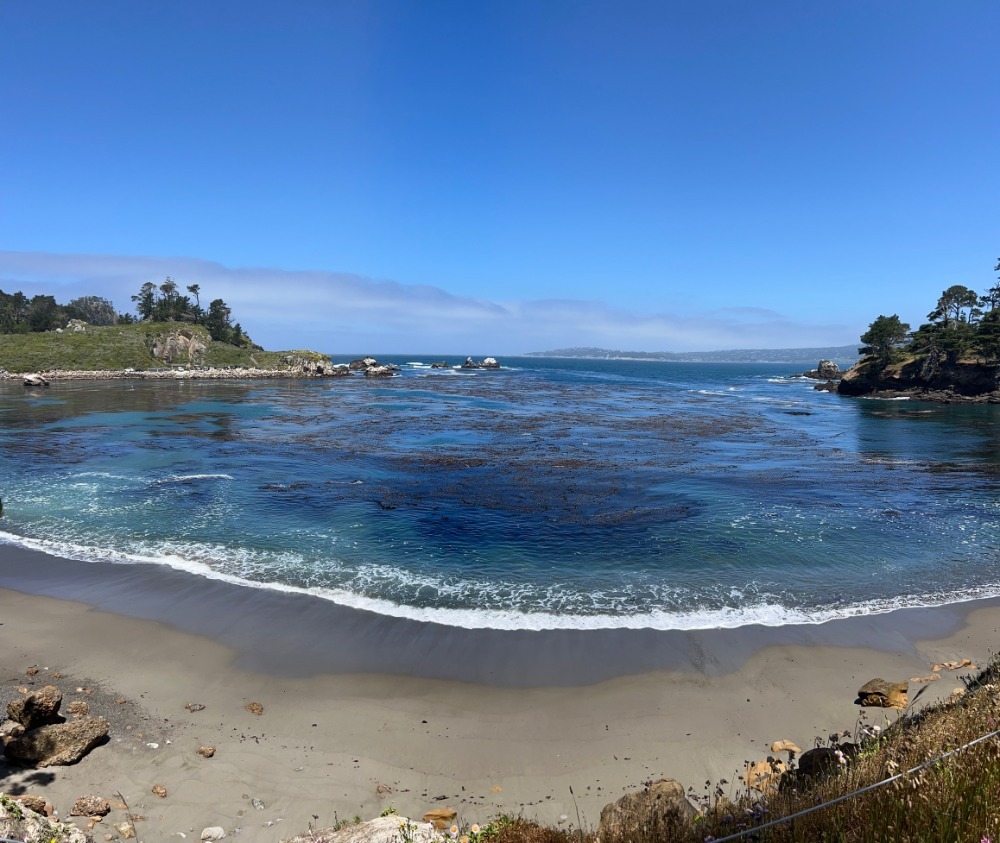 Point Lobos State Natural Reserve
A clear day at Whaler's Cove.
Photo from Keira Silver, volunteer
 Salton Sea State Recreation Area
Sunset at the park. The tires (on the right) are part of an artificial fishing reef project that was installed in the 1970s.
Photo from Eric Kung, Ocotillo Wells District
  Email photos to the WeeklyDigest@parks.ca.gov.

|
|
|
Here are some upcoming State Parks events. For a list of more upcoming events, please visit www.parks.ca.gov/events.
Saturday, June 22, 2024
-
The Art of Sleeping on Dirt (Backpacking 101)—Mount San Jacinto State Park at 11 a.m.: Interested in learning how to backpack but not sure where to start? Gone backpacking, but wanting to learn from the pros? Join park staff at the Long Valley Ranger Station, 1 Tramway Rd, Palm Springs, CA 92262, for this free class and learn not just the basics of wilderness camping, but how to camp in style! Attendance of one of these classes is a required component of the Round Valley overnight campout August 17-18, 2024 (paid event). Disclaimer: Events located in Long Valley, the Palm Springs Aerial Tramway, or other events located in the Mount San Jacinto State Wilderness require transportation via the Palm Springs Aerial Tramway. Tramway ticket fees apply. Tickets should be purchased in advance on the Tramways website. Tickets for specific tram departures are subject to availability and sell out fast during the summer months. For more information about the Palm Springs Aerial Tramway visit https://pstramway.com/
Sunday, June 23, 2024
-
The Life of the Valley Oaks—Dos Rios, 8 a.m. to noon: Dos Rios is home to some of the most magnificent valley oak trees. Join an Interpreter for a five- (5-) mile round trip hike out to the valley oak tree grove. On this hike you will learn about the valley oaks, their life, and communication system. Along the way you will also learn about the biodiversity that calls Dos Rios home. You may even see some spectacular wildlife so be sure to bring your camera and binoculars! The walking tour is not recommended for children under 8 or those with health or walking limitations. The walking tour is not ADA accessible. No strollers or pets allowed on the walking tour. Limited to 15 sign-ups.
Thursday, June 27, 2024
-
Wetlands by Boat—Folsom Lake State Recreation Area, 8:30 a.m. to 11 a.m.: Love paddling and want to learn about the natural systems you see as you are on the water? Join State Parks and Friends of Lakes Folsom and Natoma (FOLFAN) for a paddle on Lake Natoma and learn about some of the habit types that are instrumental in maintaining the health and vitality of our waterways. With guidance from FOLFAN’s Karen Shaffer, a retired aquatic biologist, we will discuss the functions and values of wetlands and riparian zones and how they fit into the larger ecosystem landscapes of Lake Natoma and its surrounding habitats. This is a casual, slow, nature observation paddle, using your kayaks, SUPs, and canoes. Basic skills and safety knowledge for the watercraft you bring is required. Personal flotation device (life jacket) is required to be worn while on the water. RSVP is required. For RSVP, questions, or concerns, please email folsomlake@ports-ca.us. Please include your name and the number of people in your party.

Lake Tahoe Area State Parks Employees Receive Huge Compliments
*Editor's note: The email below was received by Sierra District Superintendent Robert Griffith.
I hope you have a few moments to read my email as I compliment two of you state park employees working at Lake Tahoe.
First, a brief history of my experiences with the California State Parks as I feel it adds credence to my time recently spent at Sugar Pine Point State park on the west shore of Lake Tahoe. After teaching and coaching football for 32 years at Placer High School in Auburn, California, my retirement began when I was hired by Susan Grove, the district Ranger for the Lake Tahoe region. For the next 6 summers I worked at Sugar Pine Point State Park giving tours at Pine Lodge, the stately mansion on the premises of the park. As the summers progressed, Susan Grove encouraged me to offer other park experiences to those camping at the campground. Flying by the seat of my pants, I offered full moon tours, and would take select groups on a tour of the west shore, highlighting its rich history. Yet, I always wondered why the Stare Parks did not offer these types of experiences on a more formal and consistent basis.
Fast forward to the weekend of June 6-9. Much to our surprise and delight, as we pulled into the kiosk at Sugar Pine Point Campground, we noticed flyers throughout the campground offering an array of delightful parks' sponsored activities. Some of these activities included, park led full moon kayaking tours, music at both Vikingsholm and Pine Lodge, park led nature walks, campfire talks, history talks, and a stretching hour on the pier at Sugar Pine Point State Park. We tried to partake in as many activities as our weekend would provide, but our favorite was the hour of stretching led by KATIE. I do not know her last name, but the time we spent with Katie was the absolute highlight of our weekend. Katie explained that all the activities now being offered were created by KAYTLEN JACKSON, State Park Interpreter 1. Lake Tahoe Sector. Katie and Kaytlen are just a small sample of the dedicated employees who work for the state parks.
The hardwork and "out-of-the-box" thinking by Kaytlen has made the state park experience all the more endearing. The activities Kaytlen and Katie have provided will introduce the beauty of nature to so many young children. As these children age, they too will become guardians of nature and the state parks.
I hope you will take a moment to acknowledge their hardwork.
Sierra District Rangers Are Commended for Their Help in Crisis Situation
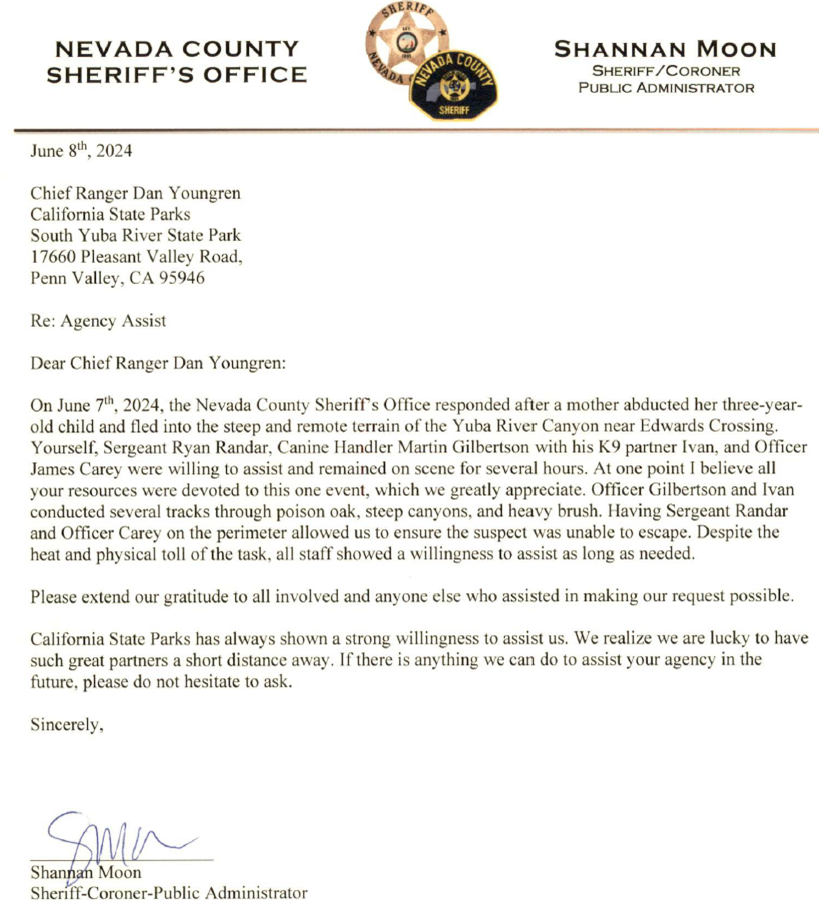 State Parks Employees Acknowledged for Role in Kitten Rescue at Candlestick Point State Recreation Area
Bay Area District employees Park Maintenance Assistant Benjamin Soler, Park Maintenance Worker I Michael Dolan, Seasonal Park Aide Phillip Hedgepath, State Park Interpreter I Evan Weissman, and Park Aide Francesca Kocks were acknowledged for their heroic assistance of a trapped kitten. The rescue is captured in this video.
|
|
|
The Weekly Digest includes a collection of news articles related to the
California Department of Parks and Recreation. The views expressed and opinions do not always reflect that of the department.
To view this week's News Clips, please visit www.parks.ca.gov/NewsClips.
 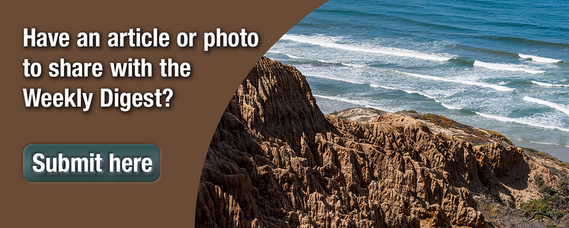 Weekly Digest Article and Photo Submissions
If you have an article or photo you would like to submit for the Weekly Digest, please send your entries via email to WeeklyDigest@parks.ca.gov.
For an article submission, please include:
- Author’s name and division/district.
- All relevant information (e.g., headline, park name, dates, name of event, individuals’ full names and titles, etc.).
Articles should be no longer than 300 words.
For photos, please include:
- Photo credit info and captions.
- Photo release forms should be kept on file for non-employees or volunteers.
Unless otherwise noted, all photos included in the Weekly Digest are courtesy of the California Department of Parks and Recreation.
The deadline for Weekly Digest submissions is close of business Thursday. For more information, email WeeklyDigest@parks.ca.gov.
|
|
|
|
|